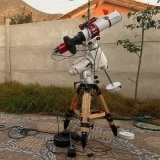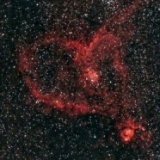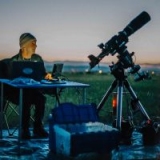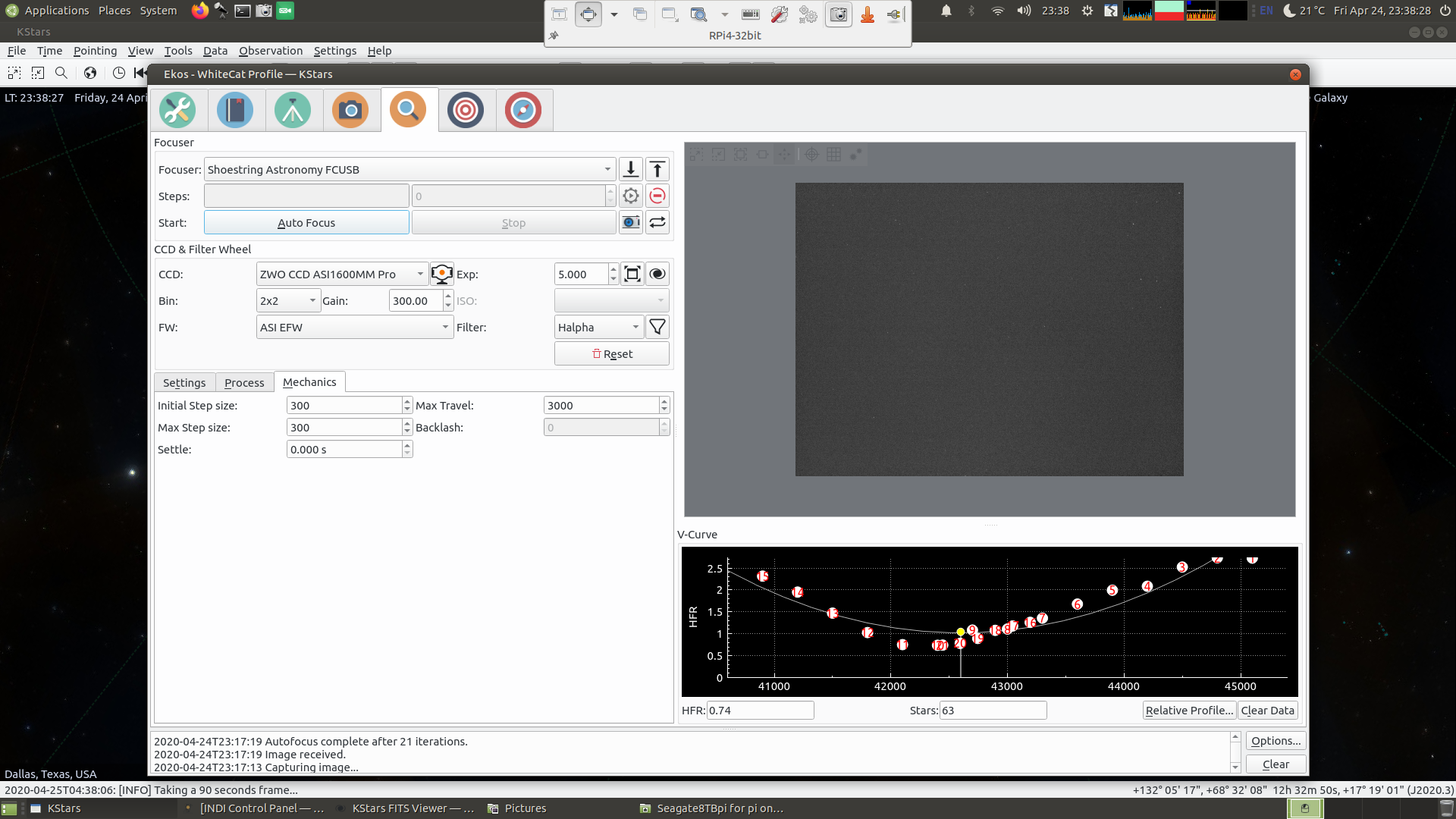So for focusing you first achieve coarse focus using an initial step size of 100 and then you start from that focus position and repeat with an initial step size of 10?
Wow, I did not know that the RASA was so finicky. Refractors are so much easier to handle and more forgiving is so many respects then.
If I understand you correctly you are seeing the same thing with the curve first going upwards and then downwards and it taking more than the expected 5 steps to reach the minimum.
I am seeing the same thing. I visually confirmed that the focus motor moves out and then moves back in again to clear the backlash before the focus run starts. Nonetheless, I think the distance it moves out should be adjustable, because the load on the drawtube moving out is lighter than when it moves back in again against the resistance of gravity.
F(o) is not equal F(i) where F(o) is the force the motor must overcome to move the drawtube outward, F(i) to move it back inward, with F(i)>F(o) as F(i)= Friction+Gravity and F(o)=Friction-Gravity.
So the motor has to perform more work, but the energy input (V x A x t) remains the same (for my analog focuser, at least, not necessarily for a stepper). So with the same amount of work (W) performed by the motor and time t being constant (invariant step size) and W=F x d, with d = distance the drawtube moves, d will be different for outward vs inward movements.
d(i) not equal d(o).
Therefore, more than the 5 expected steps are needed to return back to the minimum. as more steps are required to perform the required work. Just as Newton and Maxwell would have predicted.
Therefore, it would be great if the initial number of steps could be made adjustable to allow values other than 10, depending on how different F(o) and F(i) are. This number will vary from user to user and telescope to telescope, so it should be user adjustable.
Does that sum it up for you as well, Doug?
Other than that, Linear is one hell of powerful focusing algorithm!
Kudos to Hy for that great contribution.
×
INDI Library v2.0.7 is Released (01 Apr 2024)
Bi-monthly release with minor bug fixes and improvements
Focusing with Ekos and ZWO EAF
- Marcelo Cassese
-
 Topic Author
Topic Author
- Offline
- New Member
-

- Posts: 9
- Thank you received: 1
Focusing with Ekos and ZWO EAF was created by Marcelo Cassese
Hi all,
I've been trying to use ekos autofocusing with my ZWO EAF + ZWO ASI294 + skywatcher esprit100 but I am struggling with it. I have some few points that I am looking to get help with:
1. What is the recommended algorithm to use. I tried the gradient+polynomial as well as SEP+iterative but the first seems to work better, although still not ideal. What is typical tolerance percent value for these algorithms? 1%-2%,10%. I know this is relative to ones setup but just trying to get an idea of typical values.
2. If my focus is close to the "ideal" can I use the auto star detect or should I select the star myself? It is recommended not to choose a too bright or too dim start (mag 2-4) how do I choose a suitable star if I am selecting a star manually
3. During a in sequence HFR something odd is happening. I set a 5% threshold for the HFR to add to the measured HFR so the autofocus is triggered and set ekos to refocus . However the measured HFR is not updated on the sequence tab when autofocus is performed which is causing ekos to perform the auto focus more often than needed increasing the total acquisition time significantly.
4. For every autofocus run the convergence to a good HFR seems to take very long 7-9 trials even if the focus is close to "ideal". Is there a way to improve this convergence? This would be quite useful for in sequence autofocus since one does not need much of a change from a previous HFR value.
I would expect that Ekos autofocus would outperform a single focusing at the beginning of a sequence. I've watched the youtube ekos video tutorial on autofocus and looked at the manual but none of those answered my questions.
Thank you
Marcelo
I've been trying to use ekos autofocusing with my ZWO EAF + ZWO ASI294 + skywatcher esprit100 but I am struggling with it. I have some few points that I am looking to get help with:
1. What is the recommended algorithm to use. I tried the gradient+polynomial as well as SEP+iterative but the first seems to work better, although still not ideal. What is typical tolerance percent value for these algorithms? 1%-2%,10%. I know this is relative to ones setup but just trying to get an idea of typical values.
2. If my focus is close to the "ideal" can I use the auto star detect or should I select the star myself? It is recommended not to choose a too bright or too dim start (mag 2-4) how do I choose a suitable star if I am selecting a star manually
3. During a in sequence HFR something odd is happening. I set a 5% threshold for the HFR to add to the measured HFR so the autofocus is triggered and set ekos to refocus . However the measured HFR is not updated on the sequence tab when autofocus is performed which is causing ekos to perform the auto focus more often than needed increasing the total acquisition time significantly.
4. For every autofocus run the convergence to a good HFR seems to take very long 7-9 trials even if the focus is close to "ideal". Is there a way to improve this convergence? This would be quite useful for in sequence autofocus since one does not need much of a change from a previous HFR value.
I would expect that Ekos autofocus would outperform a single focusing at the beginning of a sequence. I've watched the youtube ekos video tutorial on autofocus and looked at the manual but none of those answered my questions.
Thank you
Marcelo
The following user(s) said Thank You: Craig
3 years 11 months ago
#52856
Please Log in or Create an account to join the conversation.
- Wouter van Reeven
-

- Offline
- Supernova Explorer
-

- Posts: 1957
- Thank you received: 420
Replied by Wouter van Reeven on topic Focusing with Ekos and ZWO EAF
Hi Marcelo,
I have been using a ZWO EAF on an Esprit 80 for a few weeks now and I am quite happy with it. I'll try to answer your questions with how I do it, though I realize that these may not be the answers you are looking for.
1. For star detection SEP is said to the the best option. For me it works very well on my Esprit refractor though it has issues on my RC because of the shadow of the secondary mirror. Still, SEP works great on my Esprit. As for the algorithm, I get really good results with both polynomial and linear. The second one takes a bit longer because it uses more steps but it works such that it eliminates the backlash in the focuser (or at least tries to). I use a tolerance of 5%. I use a step size of 100 but please be aware that this only works well with the linear algorithm if already close to ideal focus. I usually check focus first by hitting the loop button and move the focuser in and/or out until the HFR value reaches 1.5 or smaller and then I do an auto-focus.
2. I always use full field focusing with an annulus of 25% inner and 80% outer. This way many stars are included (which slows down star detection close to the ideal focus position, especially when imaging in a rich star field) and an average value for the entire fov is found.
3. Did you disable the FITS Viewer in the KStars settings? If yes, see this thread: indilib.org/forum/ekos/6756-re-problems-...s-not-coming-in.html
4. I agree that a fast convergence would save a lot of time but I prefer a GOOD focus over a FAST focus. Especially with the initial focus more steps are better. I agree that in sequence auto-focus could be executed faster.
Clear skies, Wouter
I have been using a ZWO EAF on an Esprit 80 for a few weeks now and I am quite happy with it. I'll try to answer your questions with how I do it, though I realize that these may not be the answers you are looking for.
1. For star detection SEP is said to the the best option. For me it works very well on my Esprit refractor though it has issues on my RC because of the shadow of the secondary mirror. Still, SEP works great on my Esprit. As for the algorithm, I get really good results with both polynomial and linear. The second one takes a bit longer because it uses more steps but it works such that it eliminates the backlash in the focuser (or at least tries to). I use a tolerance of 5%. I use a step size of 100 but please be aware that this only works well with the linear algorithm if already close to ideal focus. I usually check focus first by hitting the loop button and move the focuser in and/or out until the HFR value reaches 1.5 or smaller and then I do an auto-focus.
2. I always use full field focusing with an annulus of 25% inner and 80% outer. This way many stars are included (which slows down star detection close to the ideal focus position, especially when imaging in a rich star field) and an average value for the entire fov is found.
3. Did you disable the FITS Viewer in the KStars settings? If yes, see this thread: indilib.org/forum/ekos/6756-re-problems-...s-not-coming-in.html
4. I agree that a fast convergence would save a lot of time but I prefer a GOOD focus over a FAST focus. Especially with the initial focus more steps are better. I agree that in sequence auto-focus could be executed faster.
Clear skies, Wouter
The following user(s) said Thank You: Marcelo Cassese
3 years 11 months ago
#52857
Please Log in or Create an account to join the conversation.
- Marcelo Cassese
-
 Topic Author
Topic Author
- Offline
- New Member
-

- Posts: 9
- Thank you received: 1
Replied by Marcelo Cassese on topic Focusing with Ekos and ZWO EAF
Thanks a lot for your reply Wouter, I will try those approaches next time I am imaging
3 years 11 months ago
#52892
Please Log in or Create an account to join the conversation.
Replied by Doug S on topic Focusing with Ekos and ZWO EAF
I'll second the thoughts added by Wouter, and add a couple of my own. I also use the same general settings for alg, field, etc. I do wish the linear method's 10x start offset could be a bit more configurable (5x?), but that's just preference. I can get results with all three algorithms, but favor linear and poly (in that order). My RASA's CFZ is only 12 um, so focus is tough. I find myself having to watch and often manually intervene.
I'll wonder out loud if a "pupil" based focus algorithm might not yield better V curve solution results. My thinking is that similar to the sensitivity differences between Shack Hartmann and Pyramid wavefront sensors, a very out of focus pupil at 2 different distances from CFZ (both sides of focus) might yield a better V curve minima without as much seeing confusion as the focused alternatives. Not positive on this, but it would be an interesting study. After watching the existing algorithms work, I could never trust autofocus without eyes (at least for this telescope). Just too easy to get FWHM way out of whack and then have wasted integrations.
I'll wonder out loud if a "pupil" based focus algorithm might not yield better V curve solution results. My thinking is that similar to the sensitivity differences between Shack Hartmann and Pyramid wavefront sensors, a very out of focus pupil at 2 different distances from CFZ (both sides of focus) might yield a better V curve minima without as much seeing confusion as the focused alternatives. Not positive on this, but it would be an interesting study. After watching the existing algorithms work, I could never trust autofocus without eyes (at least for this telescope). Just too easy to get FWHM way out of whack and then have wasted integrations.
3 years 11 months ago
#52902
Please Log in or Create an account to join the conversation.
- Jose Corazon
-

- Offline
- Supernova Explorer
-

- Posts: 1119
- Thank you received: 182
Replied by Jose Corazon on topic Focusing with Ekos and ZWO EAF
I second what Wouter and Doug already wrote. As I am using an analog motor to drive my various self-built autofocusers (saved about $1000 that way), I found the linear focus algorithm FAR superior to all others. I still can't decide whether Centroid is better than SEP, both seem to work well, but depending on the target one may work better than the other. It takes longer but I compensate for that by increasing the gain and shortening the exposure time. I usually use 1s exposure and for most targets you don't need more. However, if you are trying to image a star poor region, or one without bright stars, you may need to increase the exposure time. Also, of course, you need to increase exposure when using narrowband filters.
There are still a few tweaks one could make to the autofocuser module, but overall, I am extremely happy with it when using a refractor. When using a mirror, there are other problems that result from the focuser moving too far out and picking up the doughnut ring. If that happens, it's game over....
There are still a few tweaks one could make to the autofocuser module, but overall, I am extremely happy with it when using a refractor. When using a mirror, there are other problems that result from the focuser moving too far out and picking up the doughnut ring. If that happens, it's game over....
3 years 11 months ago
#52904
Please Log in or Create an account to join the conversation.
- Hy Murveit
-

- Offline
- Administrator
-

- Posts: 1220
- Thank you received: 565
Replied by Hy Murveit on topic Focusing with Ekos and ZWO EAF
Doug, Jo,
Could you please let me know what the max-travel and step size parameters that you are using are?
The Linear algorithm actually should steps out 5 steps when starting, not 10, but there is some cruft from my original designs still in there
that I never cleared out (because why fix something that's working). I just want to check to see if that's affecting you.
To be clear (and just checked in my current astro-session) for me with a step size of 25, it moved out 250 steps, but then back in 125 steps, and then started working.
This out/in motion is meant to clear some backlash, but should have minimal effect on focus time. So, effectively, at least for me, it moved out 5 steps at the start.
This is not counting any motion it might make because of a filter change.
Could you please let me know what the max-travel and step size parameters that you are using are?
The Linear algorithm actually should steps out 5 steps when starting, not 10, but there is some cruft from my original designs still in there
that I never cleared out (because why fix something that's working). I just want to check to see if that's affecting you.
To be clear (and just checked in my current astro-session) for me with a step size of 25, it moved out 250 steps, but then back in 125 steps, and then started working.
This out/in motion is meant to clear some backlash, but should have minimal effect on focus time. So, effectively, at least for me, it moved out 5 steps at the start.
This is not counting any motion it might make because of a filter change.
3 years 11 months ago
#52923
Please Log in or Create an account to join the conversation.
Replied by Doug S on topic Focusing with Ekos and ZWO EAF
I'm using a 2 step process with a 100 100 start, and then a 10 10 fine. It works as you've indicated, first 10x out and back 1/2, then working by step size. In my case, I've got an odd cubic function that I don't understand that gives the algorithm a bit of a challenge. First curve is concave, then it's convex. Not sure if this is caused by the RASA focuser or by the EAF flexible coupling. It is consistent, if unexpected. In any case, I don't think it has anything to do with the alg. Fine focusing a RASA is just a challenge. Cheers, Doug
Please Log in or Create an account to join the conversation.
- Jose Corazon
-

- Offline
- Supernova Explorer
-

- Posts: 1119
- Thank you received: 182
Replied by Jose Corazon on topic Focusing with Ekos and ZWO EAF
So for focusing you first achieve coarse focus using an initial step size of 100 and then you start from that focus position and repeat with an initial step size of 10?
Wow, I did not know that the RASA was so finicky. Refractors are so much easier to handle and more forgiving is so many respects then.
If I understand you correctly you are seeing the same thing with the curve first going upwards and then downwards and it taking more than the expected 5 steps to reach the minimum.
I am seeing the same thing. I visually confirmed that the focus motor moves out and then moves back in again to clear the backlash before the focus run starts. Nonetheless, I think the distance it moves out should be adjustable, because the load on the drawtube moving out is lighter than when it moves back in again against the resistance of gravity.
F(o) is not equal F(i) where F(o) is the force the motor must overcome to move the drawtube outward, F(i) to move it back inward, with F(i)>F(o) as F(i)= Friction+Gravity and F(o)=Friction-Gravity.
So the motor has to perform more work, but the energy input (V x A x t) remains the same (for my analog focuser, at least, not necessarily for a stepper). So with the same amount of work (W) performed by the motor and time t being constant (invariant step size) and W=F x d, with d = distance the drawtube moves, d will be different for outward vs inward movements.
d(i) not equal d(o).
Therefore, more than the 5 expected steps are needed to return back to the minimum. as more steps are required to perform the required work. Just as Newton and Maxwell would have predicted.
Therefore, it would be great if the initial number of steps could be made adjustable to allow values other than 10, depending on how different F(o) and F(i) are. This number will vary from user to user and telescope to telescope, so it should be user adjustable.
Does that sum it up for you as well, Doug?
Other than that, Linear is one hell of powerful focusing algorithm!
Kudos to Hy for that great contribution.
Last edit: 3 years 11 months ago by Jose Corazon. Reason: Fixed a mistake in the formula (FacePalm)
3 years 11 months ago
#52945
Please Log in or Create an account to join the conversation.
Replied by Doug S on topic Focusing with Ekos and ZWO EAF
Jo, with great (focal) power comes much work! F2.2's achilles heal is focus. Combined with a large format camera (ASI 183), it makes it challenging to use tools I'd prefer (fast full frame with a highly zoomed viewer). The concave then convex fit is awkward, but I'm starting to characterize it enough to recognize it and work around. To be clear about your question, yes, I coarse focus using 1000 steps (100x10) back, followed by 500 (1/2) forward, then the algorithm "starts" as Hy would say. The fine pass using 10/10 is 100 back, 50 forward, and then max steps of 10 until it solves. The issue is that a good fit isn't always straight forward because the final curve is relatively flat until it jumps the other side (this may be a "feature" of EAF's resolution). I've bumped the #frames to average up to 2-3 to address variable seeing, but it definitely is a finicky process. It's an exercise of patience. When it all works, it's spectacular. When it doesn't, it can definitely kill good time searching for best focus. cheers, Doug
p.s. I need to change my prior comments on iterative & poly. Now that I've exercised all the algorithms pretty hard, I've come to the conclusion that for THIS telescope, iterative doesn't really work well. Just too quick to solve at a bad focus. Poly can work, but it's also too quick to judgement. They do solve, but not often to best focus. A big thanks to Hy for creating the linear method that can work well for more difficult setups.
p.s. I need to change my prior comments on iterative & poly. Now that I've exercised all the algorithms pretty hard, I've come to the conclusion that for THIS telescope, iterative doesn't really work well. Just too quick to solve at a bad focus. Poly can work, but it's also too quick to judgement. They do solve, but not often to best focus. A big thanks to Hy for creating the linear method that can work well for more difficult setups.
Please Log in or Create an account to join the conversation.
Time to create page: 0.473 seconds
© 2003-2022 by INDI Library. All rights reserved.

